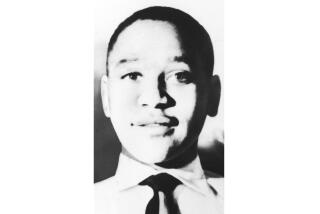Body of Civil Rights-Era Slaying Victim Exhumed
ALSIP, Ill. — Federal authorities exhumed Emmett Till’s body from an African American cemetery in this Chicago suburb Wednesday, searching for clues in a half-century-old killing that fortified the civil rights movement.
Many questions -- including a rumor that the body in the grave isn’t Till’s -- surround the slaying. The 14-year-old was killed after he reportedly whistled at a married white woman in a Mississippi Delta grocery store.
For the record:
12:00 a.m. June 4, 2005 For The Record
Los Angeles Times Saturday June 04, 2005 Home Edition Main News Part A Page 2 National Desk 1 inches; 62 words Type of Material: Correction
Civil rights -- An article in Thursday’s Section A about the exhumation of the body of civil rights-era slaying victim Emmett Till said that the August 1955 killing occurred at a time of social tumult, sparked in part by Rosa Parks’ refusal to ride in the back of a city bus in Montgomery, Ala. The incident involving Parks occurred in December 1955.
The muddy cement vault and the coffin inside it were loaded on a flatbed truck and delivered to the Cook County medical examiner’s office. Investigators said they hoped to use DNA samples taken from the remains to compare with samples recently given by the Till family to confirm the body’s identity.
At the time of Till’s death, Mississippi officials did not perform an autopsy.
FBI officials said they were searching for any clue that might help figure out who was involved in the slaying.
“For me ... the event signifies that even though the system of justice sometimes turns very slowly, it still turns,” Arthur Everett, an assistant special agent with the FBI’s Chicago office, told reporters at a news conference.
Till’s killing, one of several prominent civil rights cases reopened by the FBI in recent years, horrified the nation.
On Aug. 28, 1955 -- four days after the encounter with the white woman -- Till was dragged from his uncle’s home in Money, Miss. The Chicago teenager was visiting family in Mississippi.
His body was found three days later in the Tallahatchie River. He was beaten so severely that one of his eyes detached, and an ear was missing. His body was bound with barbed wire, and a fan from a cotton gin was tied around his neck.
Roy Bryant, the husband of the white woman, and his half-brother, J.W. Milam, were tried and acquitted of killing Till.
Later, in an interview sold to Look magazine, Bryant and Milam admitted beating and killing Till. Both men are dead.
The crime occurred at a time of social tumult, sparked in part by Rosa Parks’ refusal to ride in the back of a city bus in Montgomery, Ala., and the Supreme Court ruling in Brown vs. Board of Education that outlawed segregation in schools.
Till’s body was returned to his mother, Mamie Till Mobley, in Illinois. It was wrapped in paper and locked in a wooden crate.
Mobley broke open the lock on the crate and had her son’s body displayed in an open casket, said New York filmmaker Keith Beauchamp, who made the documentary “The Untold Story of Emmett Louis Till.”
Photographs of the funeral rallied nationwide sentiment against racist laws in the South.
The Till case was reopened last year after investigators obtained a copy of the trial transcript, as well as other evidence presented in Beauchamp’s film. The investigation is being conducted by the district attorney in Greenville, Miss., the FBI and the Justice Department.
Beauchamp said Wednesday that he had evidence that more than a dozen people were involved in the kidnapping and killing. Several of them, Beauchamp said, are alive.
“At the very least, exhuming the body is a key step in helping the investigation gather information about how Emmett died,” Beauchamp said. “It’s horrible that this has to be done. But technology exists now that didn’t back then.”
The gravediggers arrived before dawn Wednesday, carrying shovels and driving equipment across the lush green lawns of Burr Oak Cemetery.
Several hours later, investigators and about a dozen family members and friends ducked under a white tent that shaded the gravesite. A minister led the group in prayer.
“He spoke about Lazarus’ tomb, and how the dead do rise again,” said Simeon Wright, a first cousin of Till’s mother. He was with the teenager the day he was kidnapped. “It’s been almost 50 years of doing nothing. God be praised that Emmett is rising again, and we’re finally getting something done.”
As the truck left the cemetery, workers carefully picked up Till’s gravestone. The plaque, made of white and gray stone, has a small, tarnished gold locket mounted in its center. Inside is a black-and-white photograph of a smiling Till.
The workers placed it and a bunch of plastic flowers tucked near the stone in storage.
The body is expected to be returned in several days.
*
Times researcher John Beckham in Chicago contributed to this report.
More to Read
Sign up for Essential California
The most important California stories and recommendations in your inbox every morning.
You may occasionally receive promotional content from the Los Angeles Times.










